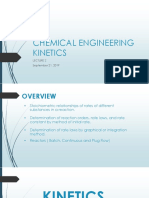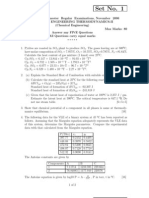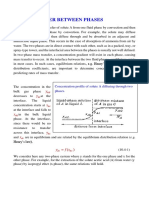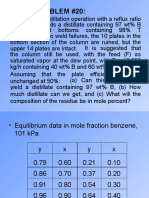0 ratings0% found this document useful (0 votes)
226 viewsTutorial 5
This document provides the solution to a chemical engineering problem involving the chlorination of dichlorotetramethylbenzene in acetic acid. The reaction is assumed to be first order with respect to chlorine and dichlorotetramethylbenzene. Kinetic data from a batch reactor experiment is used to determine the rate constant and order of the reaction. The rate constant and order are then used to calculate the volume of a plug flow reactor needed to achieve 90% conversion of chlorine using the same initial conditions as the batch reactor.
Uploaded by
Saints Burner ChristopherCopyright
© © All Rights Reserved
Available Formats
Download as PDF, TXT or read online on Scribd
0 ratings0% found this document useful (0 votes)
226 viewsTutorial 5
This document provides the solution to a chemical engineering problem involving the chlorination of dichlorotetramethylbenzene in acetic acid. The reaction is assumed to be first order with respect to chlorine and dichlorotetramethylbenzene. Kinetic data from a batch reactor experiment is used to determine the rate constant and order of the reaction. The rate constant and order are then used to calculate the volume of a plug flow reactor needed to achieve 90% conversion of chlorine using the same initial conditions as the batch reactor.
Uploaded by
Saints Burner ChristopherCopyright
© © All Rights Reserved
Available Formats
Download as PDF, TXT or read online on Scribd
You are on page 1/ 7
Process and Plant Design I tutorial 5 Solution Manual
Baciocchi et al. have studied the chlorination of dichlorotetramethylbenzene in acetic acid at
30oC. The reaction of interest has the following stoichiometry.
C6Me4Cl2 + Cl2 HCl + C6Me3(CH2Cl)Cl2
The data below are typical of those recorded in a well stirred batch reactor. Initial
concentrations are as follows:
Cl2 = 19.2 moles/m3
C6Me4Cl2 = 34.7 moles/m3
Time (ksec) Fraction of Cl2 reacted
0 0
48.4 0.2133
85.1 0.3255
135.3 0.4226
171.3 0.5195
222.9 0.5955
257.4 0.6365
a. What is the order of reaction and the reaction rate constant?
b. Determine the plug flow reactor volume necessary to acheive 90% conversion of the
input chlorine using an input volumetric flow rate of 0.15 m3/ksec and the same initial
conditions as used in the batch experiments.
Solution
(a)
The reaction is in the liquid phase and hence there are no volume changes occurring during
the reaction. From the data we are expected to find the rate equation. If we assume that the
reaction is first order with respect to chlorine and Di-chloro-tetramethyl-benzene in acetic
acid, then the schematic of the reaction is
A+B R+S
and the reaction is irreversible. The rate equation for this equation is
If we carry out a differential analysis, we know that a plot of -dCA/dt vs (1-XA). (M-XA) will
be a straight line. The line should pass through the origin and give kCA0 as the slope. See data
and graph.
Time, ks XA (1-XA)(M-XA)
0 0 1.81
48.4 0.2133 1.256
85.1 0.3255 1
135.3 0.4226 0.801
171.3 0.5195 0.620
222.9 0.5955 0.491
257.4 0.6365 0.426
(b)
The PFR performance equation is given by
We can integrate the RHS using partial fractions.
which when integrated gives a volume of 178.9 m
3
.
Continue
You might also like
- Experiment 1: Batch Reactor: Experiment 1: 6.1. Calibration Curve - Conductivity Vs ConversionNo ratings yetExperiment 1: Batch Reactor: Experiment 1: 6.1. Calibration Curve - Conductivity Vs Conversion2 pages
- University of Sabratha Faculty of Engineering Department of Chemical EngineeringNo ratings yetUniversity of Sabratha Faculty of Engineering Department of Chemical Engineering8 pages
- Gas Absorption - A Soluble Vapor Is Absorbed From: Liquid Adsorbent Below Its Bubble PointNo ratings yetGas Absorption - A Soluble Vapor Is Absorbed From: Liquid Adsorbent Below Its Bubble Point16 pages
- A Constant Volume Batch Reactor For Saponification Reaction PDFNo ratings yetA Constant Volume Batch Reactor For Saponification Reaction PDF49 pages
- Branching Applications: Ch.E. 412: Topic 2dNo ratings yetBranching Applications: Ch.E. 412: Topic 2d25 pages
- Lab 1.1 Theory - Reaction Kinetic Studies in A Batch ReactorNo ratings yetLab 1.1 Theory - Reaction Kinetic Studies in A Batch Reactor3 pages
- Saperation 1: Ass. Prof. Adnan Ripin Faculty of Chemical and Energy Engineering Universiti Teknologi MalaysiaNo ratings yetSaperation 1: Ass. Prof. Adnan Ripin Faculty of Chemical and Energy Engineering Universiti Teknologi Malaysia79 pages
- Interpretation of Batch Reactor Data: 1-Integral Method: We Guess A Particular Form of Rate EquationNo ratings yetInterpretation of Batch Reactor Data: 1-Integral Method: We Guess A Particular Form of Rate Equation12 pages
- Ch12P1 VLE Models by Margules Van Laar and Wilson EquationsNo ratings yetCh12P1 VLE Models by Margules Van Laar and Wilson Equations2 pages
- Problem Set #7 1) Run The Program Microplant As A Novice Troubleshooter and Turn in The Last Display ofNo ratings yetProblem Set #7 1) Run The Program Microplant As A Novice Troubleshooter and Turn in The Last Display of4 pages
- rr310802 Chemical Engineering Thermodynamics IINo ratings yetrr310802 Chemical Engineering Thermodynamics II8 pages
- PFR CSTR - Systems Overview and Protocols FinalNo ratings yetPFR CSTR - Systems Overview and Protocols Final20 pages
- Liquid Diffusion Coefficient Apparatus BP09No ratings yetLiquid Diffusion Coefficient Apparatus BP094 pages
- Chemical Kinetics: Chung (Peter) Chieh Professor of Chemistry University of Waterloo Waterloo, Ontario, CanadaNo ratings yetChemical Kinetics: Chung (Peter) Chieh Professor of Chemistry University of Waterloo Waterloo, Ontario, Canada34 pages
- Absorber Design Part2 Interphase Mass Transfer Rev3No ratings yetAbsorber Design Part2 Interphase Mass Transfer Rev319 pages
- Problem Set - Particle Fluid Separation201250% (2)Problem Set - Particle Fluid Separation20123 pages
- Reversible Autocatalytic Hydrolysis of ANo ratings yetReversible Autocatalytic Hydrolysis of A8 pages
- Fluid-Solid Catalytic Reactions: Rate-Limiting Step: Academic UseNo ratings yetFluid-Solid Catalytic Reactions: Rate-Limiting Step: Academic Use11 pages
- Introductory Applications of Partial Differential Equations: With Emphasis on Wave Propagation and DiffusionFrom EverandIntroductory Applications of Partial Differential Equations: With Emphasis on Wave Propagation and DiffusionNo ratings yet
- Chlorobenzenes From Benzene and ChlorineNo ratings yetChlorobenzenes From Benzene and Chlorine15 pages
- Ni Hao Hi Chi Le Ma? Have You Eaten? Zai Jian Good ByeNo ratings yetNi Hao Hi Chi Le Ma? Have You Eaten? Zai Jian Good Bye1 page
- Experiment 1: Batch Reactor: Experiment 1: 6.1. Calibration Curve - Conductivity Vs ConversionExperiment 1: Batch Reactor: Experiment 1: 6.1. Calibration Curve - Conductivity Vs Conversion
- University of Sabratha Faculty of Engineering Department of Chemical EngineeringUniversity of Sabratha Faculty of Engineering Department of Chemical Engineering
- Gas Absorption - A Soluble Vapor Is Absorbed From: Liquid Adsorbent Below Its Bubble PointGas Absorption - A Soluble Vapor Is Absorbed From: Liquid Adsorbent Below Its Bubble Point
- A Constant Volume Batch Reactor For Saponification Reaction PDFA Constant Volume Batch Reactor For Saponification Reaction PDF
- Lab 1.1 Theory - Reaction Kinetic Studies in A Batch ReactorLab 1.1 Theory - Reaction Kinetic Studies in A Batch Reactor
- Saperation 1: Ass. Prof. Adnan Ripin Faculty of Chemical and Energy Engineering Universiti Teknologi MalaysiaSaperation 1: Ass. Prof. Adnan Ripin Faculty of Chemical and Energy Engineering Universiti Teknologi Malaysia
- Interpretation of Batch Reactor Data: 1-Integral Method: We Guess A Particular Form of Rate EquationInterpretation of Batch Reactor Data: 1-Integral Method: We Guess A Particular Form of Rate Equation
- Ch12P1 VLE Models by Margules Van Laar and Wilson EquationsCh12P1 VLE Models by Margules Van Laar and Wilson Equations
- Problem Set #7 1) Run The Program Microplant As A Novice Troubleshooter and Turn in The Last Display ofProblem Set #7 1) Run The Program Microplant As A Novice Troubleshooter and Turn in The Last Display of
- Chemical Kinetics: Chung (Peter) Chieh Professor of Chemistry University of Waterloo Waterloo, Ontario, CanadaChemical Kinetics: Chung (Peter) Chieh Professor of Chemistry University of Waterloo Waterloo, Ontario, Canada
- Absorber Design Part2 Interphase Mass Transfer Rev3Absorber Design Part2 Interphase Mass Transfer Rev3
- Fluid-Solid Catalytic Reactions: Rate-Limiting Step: Academic UseFluid-Solid Catalytic Reactions: Rate-Limiting Step: Academic Use
- Introductory Applications of Partial Differential Equations: With Emphasis on Wave Propagation and DiffusionFrom EverandIntroductory Applications of Partial Differential Equations: With Emphasis on Wave Propagation and Diffusion
- Ni Hao Hi Chi Le Ma? Have You Eaten? Zai Jian Good ByeNi Hao Hi Chi Le Ma? Have You Eaten? Zai Jian Good Bye











































































